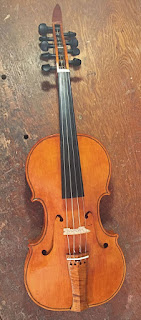Friday, November 2, 2018
First Hardanger strung up
I strung up the Hardanger two days ago. A very preliminary set-up, my first goal was to answer: will it play? I'm happy to say that it does. All the strings ring. I can play tunes on it.
I was not exceptionally happy with the tone, but that's not unusual on the first day, in my experience. Takes a while for things to stretch and compress under the string tension. And some of these strings are nylon (or some artificial material), so will stretch for a few days before settling in.
I recorded a few bits on the first day. My impression was, weirdly, that it sounded somewhat better on the recording than it did in 'real life'.
Took it to band rehearsal last night. My bandmates were all encouraging, thought it sounded great, and I was surprised to find that it could be heard in the mix with piano, guitar, and another regular fidddle.
When the other fiddler asked to play it, and I could hear it from a distance of a couple feet, I was surprised. It actually sounded louder, clearer, from a short distance away rather than right under the ear. For now, we are thinking perhaps the sound-holes, being quite different from normal violin f-holes, give the player a different experience.
I'm going to continue playing it for a few more days, then maybe take it down. I want to thin the bridge a bit -- left it at the blank thickness -- and I'd like to lower the sympathetic-string hooks on the tailpiece to give a bit more break angle across the bridge. I may want to cut another soundpost as well. This one is right on the edge of the bridge foot (east-to-west). With the very high arching on the back, the bevel is nearly 45-degrees, and I can't slide it very far in or out. So, a slightly longer one. But later.
For now, I'm going to let it, and myself, break in. I'm finding it does not like much bow pressure at all, coming much more alive with a lighter touch. A bit Baroque, perhaps?
Subscribe to:
Post Comments (Atom)






Please forgive my ignorance but what is the function of the additional tuning pegs? Beautiful looking instrument by the way.
ReplyDelete
ReplyDeleteThank you.
There are 4 strings above the fingerboard that are fingered and bowed. The other 5 strings run under the fingerboard and vibrate sympathetically, creating a drone sound.